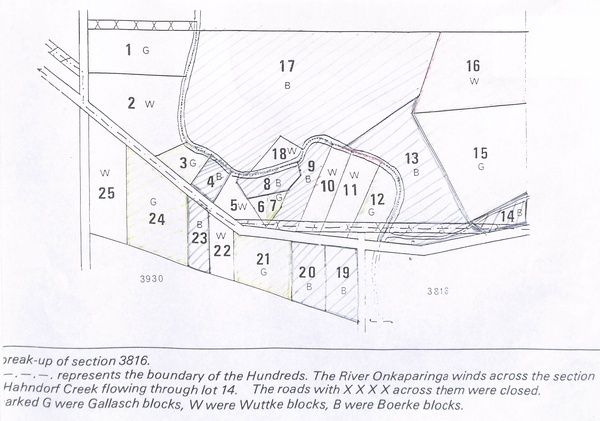[Information extracted from Reg Butler's computer files]
High up in the Mt Lofty Ranges near Hahndorf, the steep surrounding hills form a natural ampitheatre around the point where Hahndorf Creek joins the Onkaparinga River. Here, before the coming of the Europeans, Peramangk Aborigines regularly congregated to hunt and fish in such a sheltered place, and then relax and rest after they had eaten well.
During 1837-1838, bands of overlanders from New South Wales kept their cattle here with minimal supervision to fatten for the Adelaide market. Early in 1839, over fifty Prussian religious refugee families crossed this area on foot on their way to establish Hahndorf after surveyors had mapped out land suitable for agriculture. The track from Adelaide down to the junction of the two streams quickly became known as German Town Hill and the valley itself was called Klein Grünthal or Little Green Valley to distinguish it from Gross Grünthal upstream along the Onkaparinga River around the corner, a township known today as Verdun.
Ferdinand Boerke, one of the Prussians who decided not to settle in Hahndorf itself, purchased Section 3816 in the Hundreds of Onkaparinga and Noarlunga, which straddled the Onkaparinga River right in the middle of Klein Grünthal. He sub-divided this land into smaller portions which each contained direct access to the river. These allotments quickly became popular with people deciding to become market gardeners on the fertile soil which flooded each year with new sediment from further upstream.
In the years following World War 11, market gardening became uneconomic on these small holdings and other occupiers began to turn the area to different uses.
However, this movement actually began in the mid-1850s when Hahndorf’s tanner, Heinrich Storch, purchased land here to relocate his tannery downstream from Hahndorf. His original site upstream from the village was beginning to pollute Hahndorf Creek badly and people in Hahndorf itself complained loudly. The Storch homestead Ivy Home and the ruined tannery building remain attractive landmarks to this day.
Note: Above two images courtesy Mt Barker Branch, National Trust of SA.




